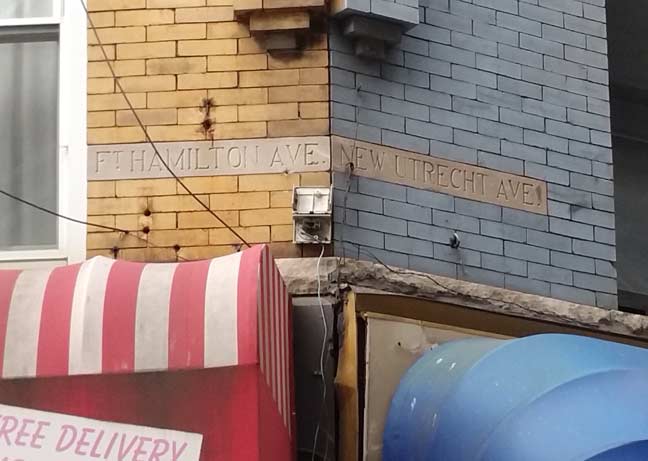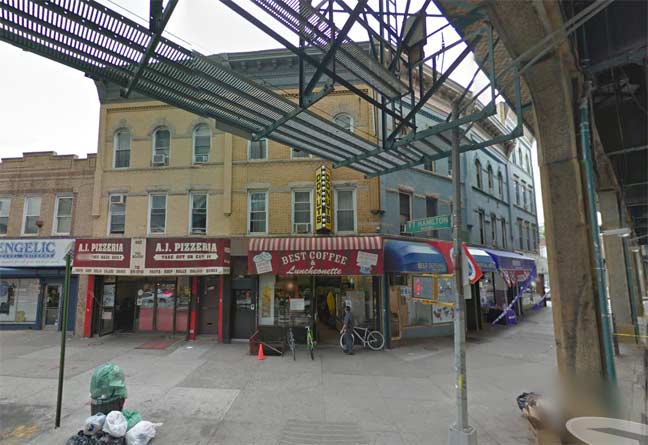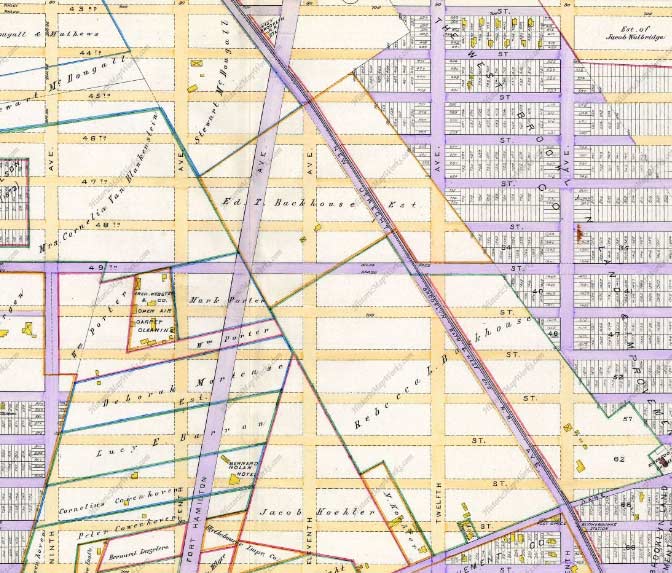
You can go by something dozens or hundreds of times without noticing it. For my first 35 years I was a Bay Ridge resident and I may have passed this little item plenty of times without ever seeing it. It’s easy to miss, on the obtuse angle of Fort Hamilton Parkway and New Utrecht Avenue, which make an X as two diagonal streets in the otherwise square grid of Borough Park. Well, that’s why I have acolytes, and FNY correspondent Gary Fonville sent it in.

Notice we are on Fort Hamilton Parkway, yet the sign says Fort Hamilton Avenue. That is the road’s original name, as it appears on maps going back as early as the 1870s with that name.

Here’s a fascinating 1890 Kings County atlas plate when this area was still part of the town of New Utrecht. The intersection in question makes an X at the top of the map. Purple indicates what streets were already open. As you can see, the neighborhood wasn’t developed all at once, as different entrepreneurs built different sections independent of each other; however, the street grid had already been surveyed, and would be built within a few years.
In those days, a steam railroad called the Brooklyn, Bath and West End Railroad ran down the center of New Utrecht Avenue, which had existed since colonial times. The railroad ran from the Green-Wood cemetery entrance at 5th Avenue and 25th Street to the West End Hotel near the water’s edge in Coney Island. In 1917, the line would be elevated on a steel trestle and for many years would be called the West End Line. In 2015, it’s merely the D train.
In 1890, the route was still Fort Hamilton Avenue, but I have a Home Life Publishing Brooklyn map from 1902 in which the switch had already been made to Parkway. Now, this map doesn’t show any structures on that obtuse angle where FHP and NUA intersect, which would show up as yellow boxes. But plenty of things can happen in 12 years!
From Comments:
Brooklyn Daily Eagle, Aug. 2, 1892, p.8, col.6: “The continuous highway, extending from the Ocean parkway through the towns of Flatbush and New Utrecht to the Shore road at Fort Hamilton and known as Fort Hamilton avenue, shall from and after passage of this act, be under the exclusive charge and management of the park commissioner of the city of Brooklyn, and shall be known as Fort Hamilton parkway.”
2/5/15

10 comments
There is something else special at this intersection, under the el are the amazing Gustavino tiles. It is an unusual place for them, but we guess that this intersection was considered important enough to receive this treatment.
Haven’t been there for a while, hope they’re still there.
What was the city’s point in making Fort Hamilton and Ray Ridge Avenues into “Parkways?” They don’t have green shoulders or medians like Ocean, Eastern or Prospect.
Perhaps it was to distinguish the grid-defying Fort Hamilton from the rest of the Borough Park’s avenues, which run north to south.
I always liked the Ft Hamilton Parkway bus route…nice pleasant long ride…
Brooklyn Daily Eagle, Aug. 2, 1892, p.8, col.6: “The continuous highway, extending from the Ocean parkway through the towns of Flatbush and New Utrecht to the Shore road at Fort Hamilton and known as Fort Hamilton avenue, shall from and after passage of this act, be under the exclusive charge and management of the park commissioner of the city of Brooklyn, and shall be known as Fort Hamilton parkway.”
While a great majority of riders simple call it the “D” train, the MTA still posts “via West End” or “West End Express” on station and route signage along the line and on subway cars. As fast as NYC can move/change, some things still hold on for a LONG time.
The “D” train used to run down McDonald Ave. where the current “F” train now runs, but we always called it the Culver Line. The West End, Sea Beach, Brighton Lines were all familiar names.
The “D” train designation has bounced all over South Brooklyn over the years. From 1954 until 1967 it was the Culver Line service, today’s F. From 1967 until 2004, it served the Brighton Beach Line. Since 2004 it has served the West End Line. The only one of the four major Coney Island routes to never see the D train has been the N (Sea Beach) route.
What they now stupidly call the “D” train now was ALWAYS the “B” train until about 2002.
The “D” train NEVER ran on the elevated “F” line (The “F” ran mostly over McDonald Ave)…The “D” train (until about 2002) was traditionally the Brighton Beach line …The “D” started in Coney Island ran mostly on sub street level open tracks on about east 17th St…..(Similar to the “N” train previously known as the “Sea Beach Line”)….
Why they idiotically changed the name of the “B” train to the “D” in 2002 is a mystery….
An even older name:
Brooklyn Daily Eagle, Sep. 4, 1872, p.2, col.4: Bay Ridge avenue… …and thence to Fort Hamilton avenue, formerly Franklin avenue.
Franklin and the later Ft. Hamilton names ran right up to Flatbush Avenue (minus the section of Ocean parkway near Park Circle.) The section of Ft. Hamilton Avenue east of park Circle was renamed as Parkside Avenue in 1902. (Brooklyn Daily Eagle, Apr. 16, 1902, p.5, col.6)
In Borough Park, there was a 10th Avenue that existed between 59th and 52nd Streets. Buildings along this length of FHP reflect that. Most Precious Blood Monastery is very noticeable, as it oriented at angle.
There are parcels of unsold city land (not easements) behind the apartment buildings along this stretch, with no public access.